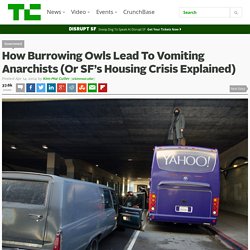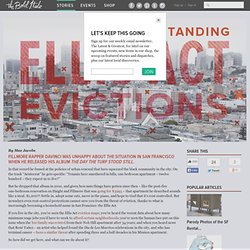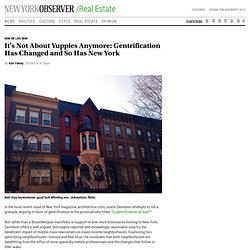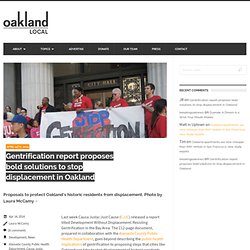

The dark side of Silicon Valley. They call it Hotel 22.
A homeless man sleeps onboard bus route 22, known as Hotel 22 This small pocket of the Golden State has become the most extreme example in the US of the growing schism between the haves and have nots. Santa Clara - the county which encompasses Silicon Valley - has the highest percentage of homeless in America, according to the latest Department of Housing report. Detroit's young gentrifiers face a daunting task in buying $500 homes: evicti... “Having to kick people out takes all the fun out of owning a house.”

Oren Goldenberg, a 31-year-old filmmaker based in Detroit, could have bought a $500 house at the Wayne County tax auction this fall-- but having to evict a homeowner turned him off. Goldenberg had been burned before. Billionaire-tech-disrupter-Sean-Parker-shakes-up-5911612. Gallery_thumbnails_show|article-gallery-5911612|article-gallery-5911612|0 gallery_overlay_open|article-gallery-5911612|article-gallery-5911612|0 gallery_overlay_open_thumbs|article-gallery-5911612|article-gallery-5911612|0 Photo: Kendrick Brinson Napster co-founder and former Facebook President Sean Parker says he used the election cycle as “a laboratory for learning” on how the ballot initiative process works.

Next year, he plans to expand with the opening of San Francisco startup Brigade, dedicated to political engagement. He is planning to go bigger in 2016. Napster co-founder and former Facebook President Sean Parker says... Photo: Kendrick Brinson Sean Parker poses for a portrait at his home in Beverly Hills, California, November 21, 2014. I Liked Everything I Saw on Facebook for Two Days. Here’s What It Did to Me. There’s this great Andy Warhol quote you’ve probably seen before: “I think everybody should like everybody.”

You can buy posters and plates with pictures of Warhol, looking like the cover of a Belle & Sebastian album, with that phrase plastered across his face in Helvetica. But the full quote, taken from a 1963 interview in Art News, is a great description of how we interact on social media today. Warhol: Someone said that Brecht wanted everybody to think alike. I want everybody to think alike. But Brecht wanted to do it through Communism, in a way. The like and the favorite are the new metrics of success—very literally. I like everything. See, Facebook uses algorithms to decide what shows up in your feed. There is a very specific form of Facebook messaging, designed to get you to interact. Jane Jacobs. More-renters-find-30-affordability-ratio-unattainable. How Burrowing Owls Lead To Vomiting Anarchists (Or SF’s Housing Crisis Explained) The Santa Clara Valley was some of the most valuable agricultural land in the entire world, but it was paved over to create today’s Silicon Valley.

This was simply the result of bad planning and layers of leadership failure — nobody thinks farms literally needed to be destroyed to create the technology industry’s success. Today, the tech industry is apparently on track to destroy one of the world’s most valuable cultural treasures, San Francisco, by pushing out the diverse people who have helped create it. At least that’s the story you’ve read in hundreds of articles lately. It doesn’t have to be this way. But everyone who lives in the Bay Area today needs to accept responsibility for making changes where they live so that everyone who wants to be here, can. The alternative — inaction and self-absorption — very well could create the cynical elite paradise and middle-class dystopia that many fear. Here is a very long explainer.
It does us all no justice. Oh, and tech? Why? No. Tech-boom-forces-ruthless-gentrification-san-francisco. Which side are you on? I first and foremost identify as an activist but I am also most definitely a code writing techie.

I have never worked for a .com, I have always been more of a .org kind of guy. It is very interesting to be caught between the activists and the nerds these days in the Bay Area. There is a lot of shouting going on but it does allow you to hear some some different points of view as the class war heats up into a cultural war that is battling for the soul of San Francisco. One of the great questions asked by labor activists for the last 100 years or so is “which side are you on”?
It is pretty clear question in most major fights for social justice. Where Are We at with Ellis Act Evictions (and How Did We Get Here?) By Max Jacobs Fillmore rapper DaVinci was unhappy about the situation in San Francisco when he released his album The Day the Turf Stood Still.

In that record he fumed at the policies of urban renewal that have squeezed the black community in the city. On the track “Aristocrat” he gets specific: “Tenants here smothered in bills, one bedroom apartment – twelve hundred – they expect us to live?” But he dropped that album in 2010, and given how nuts things have gotten since then – like the post-fire one-bedroom renovation on Haight and Fillmore that was going for $3995 – that apartment he described sounds like a steal. $1,200?! Settle in, adopt some cats, move in the piano, and hope to God that it’s rent controlled. It’s Not About Yuppies Anymore: Gentrification Has Changed. Bed-Stuy brownstones: good luck affording one.

(AdomAtom, flickr) How Many Gentrification Critics Are Actually Gentrifiers Themselves? - Emily Badger. John Joe Schlichtman recalls a particularly hypocritical scene at a wine-and-cheese reception, one of those social outings held at the end of a day of conference symposiums. The "leftist" sociologists were gathered in a historic building, designed by a famous architect, inside a major global city. Schlichtman is intentionally vague about the details because he doesn't want to too narrowly indict anyone in the sweeping critique he's about to make about academics who study urbanism. "This happens all the time, this is normal," he says of the event. 20 ways to not be a gentrifier in Oakland (Community Voices) By Dannette Lambert Gentrification is the word of the day in Oakland.

Everywhere you look people are asking, “Am I a gentrifier? Is it bad? Should I care?” What people don’t seem to realize is it isn’t the mere act of moving into a neighborhood that makes you a gentrifier; it’s what you do once you get there. If you come into someone’s home, do you immediately start rearranging it and moving furniture in? No, of course not. And yet, recently arrived residents of Oakland are doing just that. Gentrification report proposes bold solutions to stop displacement in Oakland. Last week Causa Justa::Just Cause (CJJC) released a report titled Development Without Displacement: Resisting Gentrification in the Bay Area.

The 112-page document, prepared in collaboration with the Alameda County Public Health Department, goes beyond describing the public health implications of gentrification to proposing steps that cities like Oakland can take to stop displacement of historic residents. Gentrification’s insidious violence: The truth about American cities. A few years back, when I was still a paramedic, we picked up a white guy who had been pistol whipped during a home invasion in Williamsburg. “I can’t believe this happened to me,” he moaned, applying the ice pack I’d given him to a small laceration on his temple. “It’s like a movie!” Indeed. Rebecca Solnit · Diary: Google Invades · LRB 7 February 2013. The buses roll up to San Francisco’s bus stops in the morning and evening, but they are unmarked, or nearly so, and not for the public. They have no signs or have discreet acronyms on the front windshield, and because they also have no rear doors they ingest and disgorge their passengers slowly, while the brightly lit funky orange public buses wait behind them.
The luxury coach passengers ride for free and many take out their laptops and begin their work day on board; there is of course wifi. Most of them are gleaming white, with dark-tinted windows, like limousines, and some days I think of them as the spaceships on which our alien overlords have landed to rule over us. Other days I think of them as the company buses by which the coal miners get deposited at the minehead, and the work schedule involved would make a pit owner feel at home. Another friend of mine told me a story about the Apple bus from when he worked for Apple Inc. The Google Bus means so many things. The Devastating Effects of Concentrated Poverty - Ta-Nehisi Coates.